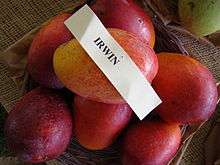Irwin (mango)

The 'Irwin' mango is a commercial mango cultivar which was developed in South Florida.
History
The original 'Irwin' tree was a seedling of the 'Lippens' cultivar that was open-cross pollinated with 'Haden',[1] planted on the property of F.D. Irwin in Miami, Florida in 1939.[2] The tree first bore fruit in 1945 and was named and described in 1949.[3] The fruit gained commercial acceptance due to its good production, flavor, relative disease resistance, and attractive color. 'Irwin' has also been sold as a nursery stock tree for home growing in Florida.
Today 'Irwin' is grown on some commercial scale in a number of countries, including Japan, Taiwan, and Australia, where it was introduced in the 1970s.[4]
'Irwin' trees are planted in the collections of the USDA's germplasm repository in Miami,[5] the University of Florida's Tropical Research and Education Center in Homestead, Florida,[6] and the Miami-Dade Fruit and Spice Park,[7] also in Homestead.
Description
'Irwin' fruit is of ovate shape, with a rounded base and a pointed apex, lacking a beak. The smooth skin develops an eye-catching dark red blush at maturity. The flesh is yellow and has a mild but sweet flavor and a pleasant aroma.[8] It is fiberless and contains a monoembryonic seed. The fruit typically mature from June to July in Florida[9] and is often born in clusters.
The trees are moderately vigorous growers capable of exceeding 20 feet in height if left unpruned, developing open canopies.
References
- ↑ http://fshs.org/Proceedings/Password%20Protected/2005%20v.%20118/118/192-197.pdf
- ↑ http://www.hort.purdue.edu/newcrop/Morton/Mango_arS.html#Varieties
- ↑ http://www.fshs.org/Proceedings/Password%20Protected/1954%20Vol.%2067/284-290%20%28LEDIN%29.pdf
- ↑ http://www2.dpi.qld.gov.au/horticulture/5374.html
- ↑ http://www.ars-grin.gov/cgi-bin/npgs/acc/display.pl?1207222 USDA, ARS, National Genetic Resources Program. Germplasm Resources Information Network - (GRIN). [Online Database] National Germplasm Resources Laboratory, Beltsville, Maryland.
- ↑ http://trec.ifas.ufl.edu/crane/pdfs/TREC-Fruit-Collections.pdf Page 3, #48
- ↑ http://fruitandspicepark.org/friends/index.php?option=com_content&task=view&id=43&Itemid=29
- ↑ Campbell, Richard J. (1992). A Guide to Mangos in Florida. Fairchild Tropical Garden. p. 81. ISBN 0-9632264-0-1.
- ↑ http://edis.ifas.ufl.edu/mg216 Table 1